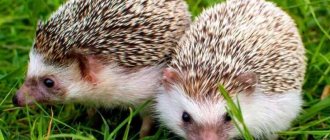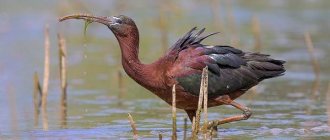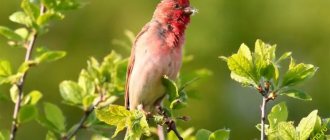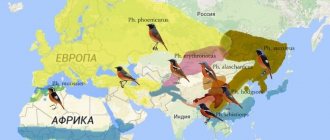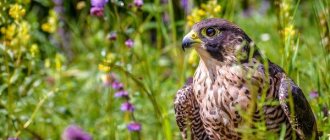| Kingdom | Animals |
| Sub-kingdom | Multicellular |
| Type | Chordata |
| Class | Birds |
The class of birds in the process of evolution was formed under the influence of adaptation to flight.
Birds are similar to reptiles in many ways. The class of birds is divided by feeding method:
- herbivores;
- insectivores;
- herbivorous-insectivorous;
- predatory;
- omnivores;
habitat:
- ground;
- waterfowl;
- forest birds;
- swamp-meadow;
- birds of populated areas.
Birds have spread to all continents of the globe. Some of them spend most of their lives on the open sea. On land, different species of birds are found everywhere where there is plant or animal food for them - in forests, bushes, parks, shelterbelts, meadows, swamps, deserts, mountains and tundra.
Birds are in many ways similar to reptiles, which is manifested in the presence of horny scales on the hind limbs and the horny covering of the beak, as well as the almost complete absence of skin glands.
General information about birds pigeon
The pigeon is the most common bird on the planet. Small in size, pigeons come in different colors, depending on the species. The plumage fits tightly to the body and is quite thick.
The largest individual weighs about 400 grams. On average - 250. The body of a pigeon is up to 40 centimeters long, oblong in shape. Wide wings, the tips of which are sharp, can reach a span of up to 70 centimeters. The limbs of a pigeon have no feathers. The beak is dark-colored, medium size.
From the description of the pigeon bird, you can find out that this bird was previously domestic, but over time it began to live in the wild. Of course, along with free life, poultry is also found, but primarily the pigeon should be classified as a wild bird.
The white dove was named the bird of peace after the end of World War II. It was he who then symbolized peace on the emblem of the World Congress.
How is the bird behaving?
The interpretation of the sign depends on the behavior of the arriving pigeon.
Looking out the window
A bird sitting outside the window, when it looks closely and for a long time at the owner of the apartment, indicates that someone is greatly homesick for this person. If the chosen one is away, the bird sends greetings from him.
- Sometimes the soul of a loved one who has passed away is hidden under the guise of a bird. The dove looks through his eyes - how you live without him.
- We noticed that the gray-winged one copies you, turns its head in the same direction - this is a sign that you need to finish a long-delayed task, make a decision, make a choice.
Sits for a long time and does not fly away
- It sits for a long time, sometimes more than one day, and does not fly away - a warning of impending danger and trouble. To ward off trouble, the bird must be fed. Carefully place crumbs or cereal onto it.
- Sitting with his back to the window for a long time and looking enthusiastically forward or to the side - get ready for a long trip.
Landed and immediately flew away
- He sat down on your window for a while, is not interested in you or the apartment - his behavior means nothing. He simply sat down to rest and went about his business again.
- If you looked into the house and showed interest in you, expect news soon.
If it appears often
- A frequent pigeon, according to legend, tries to bring lost joy into the house, improve relationships and make the life of household members happier.
- Signs and some beliefs connect these birds with Guardian Angels. Don't drive the bird away, feed him, welcome him and meet him with a kind heart. Perhaps he will protect you from misfortunes and adversity.
- According to another popular belief, the same bird flies to the window of a deeply lonely person. Try to open up to people, find friends and support.
- When the owner of the house constantly chases away the bird, but it constantly returns, you need to prepare for minor troubles.
Why is he walking on the windowsill?
Seeing a bird walking on the windowsill is a good omen. It is important that a bird slowly walking along the windowsill announces the imminent arrival of an influential person in your home, on whom your fate may depend. This guest is able to assist in solving problems.
Knocking on the window
- A decisive knock on the glass with its beak indicates news.
It is impossible to say for sure whether the news is good or bad. Attention! If you are ready for change and crave it, after the bird flies away, open the window and let the changes it brought into your life. If you do not want to take risks, you are satisfied with the current state of affairs, knock on the glass and say: “What news you brought, take it away!” - A persistent and prolonged knock on the window means that one of the family members is ill.
- Hitting the glass with its entire chest or wings - to trouble and chagrin.
Shit
Seeing pigeon marks on the glass or windowsill is very unpleasant. However, don't be upset. The sign indicates the arrival of wealth in your home. Soon your financial situation will improve and you will make a profit.
Coos
- Two peacefully cooing doves - to all sorts of success in your personal life.
- One cooing dove is also a good omen. He promises a young girl a meeting with her betrothed and a wedding, and the groom will be wealthy. For families - the resurrection of forgotten feelings, the cessation of omissions and quarrels.
- However, if the cooing drags on, it is a warning of impending troubles.
Cleans feathers
A pigeon that has landed on the windowsill sits and peacefully preens its feathers - the apartment owners do not associate anything specific with such behavior. This happens before the weather changes.
Habitat of the pigeon bird in the wild
Pigeons can be found in almost every corner of the globe. The only exceptions are the North and South Pole. A pigeon can live anywhere: in the mountains, in deserts, in dense forests. Can live closely with humans. There are quite a few species, and about 9 of them are found in Russia alone.
Salmonellosis (paratyphoid)
Paratyphoid fever, also known as salmonellosis, occurs when the Salmonella bacteria enters the body of pigeons; infection occurs through the esophagus; cases of infection through the respiratory tract are less frequently recorded. The bird dies due to poisoning, internal bleeding or sepsis.
The bacteria multiply in the intestines of the bird, as well as in the lungs, liver and kidneys, joints and brain. Chicks and young pigeons suffer the disease more severely; in them, the infection causes an acute course and causes 90% of the death of young animals.
In adults, the disease occurs in a subacute, sometimes latent form; its presence can be suspected by eggs with non-viable embryos.
Signs of salmonellosis:
- depressed state;
- elevated temperature;
- refusal of food;
- thirst;
- green liquid excrement, sometimes mixed with blood.
Due to weakness, pigeons move with difficulty, feathers bristle and fall out.
When joints are involved in the inflammatory process, an increase in the joint capsule is observed, the limbs lose mobility, and the muscles of the wings are tense.
Important! Damage to the nervous system develops with a long course of the disease, the bird walks staggering, can fly in circles, convulsions, paresis, and paralysis develop.
Structural features of the pigeon bird
The body of the bird is very powerful and strong, the head is small. The limbs have 4 fingers and are well developed to move along the ground. Three fingers are in front, one is behind. Thanks to this structural feature, the pigeon not only flies, but also walks easily.
Pigeons can cover long distances, reaching speeds of up to 140 kilometers per hour. It is not for nothing that in the old days they were used as postal couriers.
Females can be distinguished from males only by size. Typically males are always larger. It will not be possible to do this by color, since the plumage of both is the same.
The pigeon's body lacks a gallbladder. For a long time there was a theory that these birds do not secrete bile. However, this is not true: after excretion, it simply immediately enters the digestive system.
Pigeons are well oriented by the light of the sun, smell and magnetic field. In flight, a pigeon can reach a height of up to 3 kilometers. But a pigeon can return to its native place even at a distance of 1000 kilometers. Pigeons also sense the approach of a thunderstorm or earthquake well. These birds are also able to distinguish infrasound.
Organ systems
Digestion
The digestive organs begin with the beak - this is the main organ for capturing prey. The beak consists of an upper part (the mandible) and a lower part (the mandible). The shape and structural features of the beak are different in different birds and depend on the method of feeding. An adaptation to flight is the absence of teeth, which makes the body lighter.
The tongue is attached to the bottom of the oral cavity; its shape and structural features depend on the nature of the food. The ducts of the salivary glands open into the oral cavity. Food moistened with saliva is easily swallowed and enters the esophagus, the lower part of which in many birds forms an extension - a crop (in which the food is soaked and partially digested).
Further along the esophagus, food enters the thin-walled glandular stomach, in which numerous glands secrete digestive enzymes. Enzymatically processed food passes into the gizzard. The walls of the muscular stomach are well developed, strong muscles, due to the contraction of which food is ground. The ground food enters the duodenum, into which the ducts of the pancreas and gall bladder flow. The food then enters the small intestine, and undigested remains are excreted through the large intestine into the cloaca. Birds are characterized by high digestion intensity.
Waterfowl and some other birds have a coccygeal gland at the base of the tail - birds lubricate their plumage with its secretion, which thanks to this becomes water-repellent, elastic and resilient.
Breathing
The respiratory organs begin with the nostrils, located at the base of the beak. From the mouth, the laryngeal fissure leads into the larynx, and from it into the trachea. In the lower part of the trachea and the initial sections of the bronchi there is the vocal apparatus of birds - the lower larynx.
The bronchi penetrate into the lungs, branching into small tubes - bronchioles - and very thin air capillaries, which form an air-carrying network in the lungs. Blood capillaries are closely intertwined with it, through the walls of which gas exchange occurs. Some of the bronchial branches are not divided into bronchioles and extend beyond the lungs, forming thin-walled air sacs located between internal organs, muscles and even inside hollow bones. The volume of the air sacs is almost 10 times the volume of the lungs. The paired lungs are small and have little extensibility; they grow into the ribs on the sides of the spine.
Blood
The bird's heart is four-chambered, divided by a longitudinal septum into left and right halves, the right (venous) half is completely separated from the left (arterial).
The large and small circles of blood circulation are completely separated. The systemic circulation begins from the left ventricle and ends in the right atrium; arterial blood is carried through the arteries throughout the body (all organs are supplied only with arterial blood), venous blood through the veins enters the right atrium, and from it into the right ventricle. The pulmonary circulation begins from the right ventricle and ends in the left atrium. Venous blood through the pulmonary arteries enters the lungs and is oxidized there, and arterial blood through the pulmonary veins enters the left atrium, and from it into the left ventricle and systemic circulation.
Birds have a relatively large heart. The intensity of the heart is also high: the pulse at rest is 200-300 beats per minute, in flight - up to 400-500 (in birds of medium size). The large volume of the heart and rapid pulse ensure rapid blood circulation in the body, intensive oxygen supply to tissues and organs and removal of metabolic products.
Discharge
The excretory organs are represented by two large kidneys, constituting 1-2% of body weight; they lie deep in the pelvis on both sides of the spine. Through two ureters, uric acid in the form of a white mushy mass flows into the cloaca and is excreted out along with excrement. Birds do not have a bladder.
Birds are warm-blooded animals; they have a constant and fairly high (on average 42°C) body temperature. The warm-bloodedness of birds (and mammals) is due to an increase in the level of metabolism through the intensification of digestion, respiration, blood circulation, excretion and the presence of heat-insulating covers. The constancy of body temperature and its independence from the environment is an important progressive feature of birds and mammals compared to previous classes of animals.
Nervous
The brain, especially the large hemispheres of the forebrain, the large optic lobes of the midbrain and the cerebellum, are better developed than in fish, amphibians and reptiles.
This is associated with more complex and varied behavior and flight ability.
Feelings
Of the sense organs, vision is the best developed. The eyeballs are large, which allows the retina to produce large images with clear details. The eye has three eyelids - the upper, lower and transparent inner, or nictitating membrane.
Accommodation (focusing the eye) is carried out by changing the shape of the lens and simultaneously changing the distance between the lens and the retina, as well as some changing the curvature of the cornea. All birds have color vision. The visual acuity of birds is several times higher than the visual acuity of humans.
The organ of hearing is anatomically similar to the organ of hearing of reptiles and consists of an inner and middle ear. In the inner ear, the cochlea is better developed, and the number of sensitive cells in it is increased. The cavity of the middle ear is large, the only auditory bone - the stapes - is of a more complex shape, it is more mobile when the dome-shaped eardrum vibrates. The eardrum is located deeper than the surface of the skin; a canal leads to it - the external auditory canal. Birds hear very well. Covering feathers located around the eardrum help them in this. Birds have very acute hearing.
Compared to reptiles, birds have an increased surface area of the nasal cavity and olfactory epithelium. Some birds have a well-developed sense of smell and use it in search of food (ducks, waders, carrion-eating predators, etc.). In other birds, the sense of smell is poorly developed.
The taste organs are represented by taste buds in the mucous membrane of the oral cavity, on the tongue and at its base. Many birds distinguish between salty, sweet and bitter.
Reproduction
The breeding of each bird species begins in such a way that the growth of the chicks occurs at the most abundant time of the year.
Nesting behavior is governed by hormones, highly complex instincts, and the birds’ own experiences. The body receives the signal to begin reproduction from the pituitary gland, the main endocrine gland located at the base of the brain. When daylight reaches a certain length, the pituitary gland begins to produce a hormone.
Under its influence, sex hormones are produced in the gonads, the formation of germ cells begins, and the appearance and behavior of birds changes.
The bird's experience helps it cope with tasks faster and better.
The entire complex chain of hereditary nesting behavior programs is checked each time by natural selection.
By introducing a sex hormone, the female can be forced to build a nest at any time of the year. But the nest will be rough. Under natural conditions, she develops a sensitive brood spot at this time. Sitting down on the nest, the female notices all the irregularities and lines them with more delicate, warm material. But the loss of feathers depends on another hormone, the release of which is caused by the appearance of the male.
Eggs or the open mouths of chicks by their appearance “switch on” another hereditary behavior program in the female’s brain - incubation or feeding.
Most birds incubate their eggs in a nest. Most often, birds build or weave nests from twigs, grass, moss, often fastening them with additional material (hair, wool, clay, mud, etc.). The nest usually has raised edges and a recessed interior called a tray that holds the eggs and chicks.
The embryo in the egg develops very quickly at high temperatures (37-38°C) and certain humidity. These conditions are provided by the bird incubating the clutch. The hen regularly turns the eggs, changes the density of incubation: when the air temperature is too high, the bird rises in the nest, cools the clutch, periodically wetting the plumage, and protects it from the sun's rays with its own shadow.
Reproductive organs
The male has two testes, the vas deferens form a small expansion in the lower part - the seminal vesicle - and flow into the cloaca.
The female has only one left ovary and a left oviduct, which flows into the left side of the cloaca.
Egg structure
Bird eggs are large and contain a lot of nutrients and water in the white and yolk. First, the egg is covered with an albumen, then with two fibrous (subshell) and then with a shell membrane. The germinal disc is visible on top of the yolk - the result of crushing (division) of the fertilized egg. The yolk, suspended on flagella - chalazas, is located in the center of the egg. The lower part of the yolk is heavier, so when turning the egg, the germinal disk is always located on top, in the best conditions for heating during incubation.
The outside of the egg is protected by a calcareous shell, which contains numerous microscopic pores. Through them, gas exchange occurs between the developing embryo and the external environment. The lime from the shell is partially used to form the skeleton of the developing embryo. On top of the calcareous shell, the egg has a thin supershell shell, which protects it from the penetration of microbes.
Pigeon bird lifestyle
Pigeons were originally domesticated poultry. They were bred and used for meat. Gradually, the breeding of pigeons moved into a more peaceful direction: some breeds were bred for decorative purposes, and then for sporting purposes. Until now, pigeons have not lost the ability to be domesticated and now, as before, they are easily tamed.
Nowadays, pigeons prefer to settle in hard-to-reach places, mainly on the banks of reservoirs or mountains. By the way, for this reason, few can say that they have seen pigeon chicks. Pigeons often settle near farmland, because that is where they can get their food.
Birds build nests together. Usually the female forms it from the building material that the male collected and brought.
Pigeons usually choose one partner. Lonely individuals can quarrel with each other and fight. The female is capable of laying eggs several times a year. They are incubated for 20 days, after which naked, down-covered chicks are born. The couple feeds them with milk from the crop for 3 weeks, after which they gradually begin feeding them grain crops.
Pigeons have many ill-wishers who want to eat them. Large birds, such as a falcon or a kite, lie in wait for them in the air. On the ground, pigeons should be careful of rats or martens.
Smallpox
A viral infection of birds, characterized by a chronic course, the development of conjunctivitis and the formation of foci of rash on the head. In the diphtheroid form, damage involves the mucous membrane of the respiratory tract.
Young birds are sensitive to the disease; in chicks, the pathology usually damages the respiratory system; with reduced immunity, a mixed type of disease develops. In adults, lesions on the skin are more often observed, and a severe course is observed during periods of molting.
Smallpox is caused by a virus of the genus Avipoxvirus. The pathogen is excreted in feces, nasal mucus, and discharge from the eyes; in the skin form, discharged films and scales also contain an infectious agent. The eggs of a sick individual are also infected with the virus.
With any type of disease, the pigeon is depressed, the feathers are ruffled, the appetite is reduced or absent, the symptoms depend on the type of pathology:
Cutaneous form
It is characterized by the appearance of pale spots, which later turn red and transform into nodules. Gradually, they merge into warty growths, secreting a sticky exudate; when it dries, brownish crusts form.
In an uncomplicated process, dry scabs disappear after a week or 10 days. After 3 weeks, a relapse of exacerbation cannot be ruled out.
Diphtheroid form
It develops when the pathogen spreads to the mucous membrane of the nasopharynx, trachea and bronchi, and sometimes in the intestines. Light raised nodular elements are formed.
They enlarge, unite, acquire a yellowish color, create a dense film or appear as cheesy inclusions of necrosis. The plaque does not allow the pigeon to fully feed and breathe, causing blockage of the larynx and suffocation.
Conjunctivitis is manifested by lacrimation and intolerance to light, mucous and purulent discharge with the formation of crusts that stick together the eyelids.
Secondary infection causes inflammation of the cornea, which can spread to all tissues of the eyeball, which causes loss of the eye.
Attention! The pigeon recovers with an uncomplicated course of the disease; poor housing conditions and an unbalanced diet weaken the bird, can cause secondary infection of the affected areas with pathogenic microflora and lead to the death of 3/4 of the flock.
Pigeon bird feeding
Pigeons eat almost everything. This unpretentiousness is explained by the fact that pigeons have very few taste buds. In the wild, birds easily find seeds and leftover food, small fruits and leaves. Moreover, pigeons do not digest the fruit seeds and regurgitate them back.
In urban conditions, birds get used to being fed by people, remember the feeding place and often fly to it. Pigeons also need water. They, unlike other birds, do not collect moisture drop by drop so that it then flows down their throats, but draw it in.
Psittacosis
Ornithosis, or psittacosis, is a common infectious pathology of pigeons caused by the intracellular organism Clamydophila psittaci, which affects the intestines and parenchymal organs.
The pathogen lives in the bird’s body in a latent state, the trigger for the development of the disease is stress or a decrease in immunity caused by unfavorable living conditions. The infectious agent is transmitted through food or air.
Respiratory chlamydia spreads quickly and, if kept in a crowded environment, can infect the entire population of a dovecote.
An infected bird can be recognized by the following signs:
- the dove sits ruffled, with drooping wings and closed eyes;
- no appetite;
- mucus flows from the nasal passages;
- there is lacrimation and hoarse breathing;
- Liquid droppings are white, sometimes green;
- runny nose.
The latent form develops when chlamydia penetrates the intestines; infection is manifested by decreased activity, decreased appetite, and periodic diarrhea.
Why do people breed pigeons?
Of course, now this activity is not as widespread as it used to be, but some are still breeding this bird. If previously the purposes were exclusively for food, now people breed pigeons to participate in exhibitions or sports competitions.
Pigeons are quite smart birds. Scientists have proven that they are able to think and easily switch from one task to another.
Domestic pigeons can live up to 20 years. In the wild, approximately 5-6 years. This variation in time is explained by careful care and the absence of dangers from predators when kept at home.
Sits on the roof of a house
- This is the best sign. It means that your home is under the powerful protection of Higher powers.
- In addition, a dove on the roof of a private household indicates that kind, pure-hearted people live here.
- A white dove on the roof promises a young girl an early marriage. If a white bird lands on the roof of a house where an old sick person lives, the sign speaks of his possible departure to another world.
- A nest under the roof means a happy, prosperous life. Troubles and misfortunes will bypass your home. In addition, this indicates your invulnerability to dark magic; conspiracies and witchcraft spells do not affect you.
Types of pigeons
As a rule, pigeons are conventionally divided into the following categories:
- Postal
- Decorative
- Meat
- Racing
One breed can belong to different categories. These categories differ in the following characteristics:
Postal
They are well oriented in space and easily find their nests, strong and hardy
Decorative
They differ in plumage and color from other individuals. The body structure, organ development, and feather structure are also different from other representatives.
Meat
Popular when preparing dietary dishes, considered a delicacy
Racing
They differ in flight styles. Some fly high into the sky in circles or make sharp turns as they fly. Other representatives do not rise very high, but they perform somersaults in the sky
Distinctive characteristics table
Experienced breeders analyze a set of parameters to accurately determine the sex of a pigeon. The final table of distinctive characteristics, which can be found below, will allow you to avoid mistakes in this matter:
| Characteristic | Females | Males |
| Bird sizes | The body dimensions of the doves are quite miniature. | They have a strong and powerful body. |
| Head | It has a round shape, devoid of bulges and irregularities. The neck is quite thin, and the wax and beak are graceful. As a rule, doves look with expressive eyes. | It has a rather pronounced frontal part. The neck is wider, and the beak and cere are developed and massive. Pigeons look with large and round eyes. |
| Plumage color | As a rule, it is monochromatic and lacks bright shine. | Males often have bright colored patches on their chest, wings and tail. Their body can be decorated with ornate patterns. In the neck area, feathers often shimmer in various shades - green, blue, burgundy. |
| Voice | More calm and melodic. It is believed that the doves burr slightly. | Quite loud, as the individual tries to attract the attention of females or scare away opponents. Their roar can be quite aggressive. |
| Interaction with individuals of the opposite sex | To express sympathy for the male they like, doves can dance slightly, coo and sit on their tail. If the female is already busy, she can react quite aggressively to an outside male. | When a pigeon likes a female, it begins to court her, show off its color, coo loudly and perform a courtship dance. He may even hug the “lady,” taking her under his wing. |
| Interaction with individuals of the same sex | Females react calmly to each other and can even enter into friendly relations. | Males often show aggression towards each other and begin to fight to prove their leadership and superiority. |
So, to find out the sex of a pigeon, you need to take into account a number of parameters - the size of the head and beak, the color of the feathers, the structure of the pelvic bones, character and behavior during the mating season. In addition, there are a number of folk methods that have proven effective in practice and are used by many breeders. All these methods can be used in combination to maximize the accuracy of determining the sex of a bird.
0
0
Copy link
Breeds of pigeons
wood pigeon
A large gray individual with white stripes on the tail and wings. Lives in the forest, does not live next to people
Belgian postal
Developed and hardy, characterized by fast flight
Peacock
White in color, a frequent “guest” at weddings due to its beautiful plumage
Curly
The plumage is wavy, and it covers not only the body, but also the legs. Color can be varied
Nikolaevsky
Its flight pattern is similar to that of a lark. Various colors
What does it mean when you showed up for a holiday?
- A dove on the window at the Annunciation will bring news of an imminent pregnancy and the birth of a child.
- Palm Sunday promises good health, longevity, inexhaustible energy and financial stability.
- On the days of the Honey, Apple, and Walnut Savior, a dove on the windowsill indicates that you are under the protection of a Higher Power. Your work and efforts will not be in vain, you will reap a rich harvest and receive recognition.
A dove, no matter what color it is, no matter how it behaves, no matter what message it arrives with, is just a messenger, a guide, designed to convey information about future events. If you pay attention to these signs, you can draw conclusions in advance, prepare for the inevitable, or prevent unwanted events. We must thank the feathered messengers for the warning and not hold a grudge against them.
Photos of all types and breeds of pigeons
Coccidiosis
The pathology is caused by the simplest organisms – coccidia. Mostly young animals become ill when they ingest a significant amount of oocysts with contaminated feed and water.
Coccidiosis is characterized by damage to the digestive tract, destruction of the intestinal walls, manifested by:
- depressed state;
- loss of appetite and weight loss of poultry;
- frequent loose bowel movements;
- mucus and streaks of blood are noticeable in the stool, sometimes the droppings become brown in color;
The progression of the disease leads to movement disorders and paresis of the limbs.
Eye diseases
Improper keeping of pigeons often leads to eye diseases. Inflammation is caused by viruses, bacteria, and parasites. The cause of the disease can also be vitamin deficiency.
A lack of vitamin A is especially dangerous. As soon as its content in the feed is increased, the problem goes away.
Other causes of eye diseases:
- unsanitary conditions;
- infectious diseases - eye diseases are often concomitant;
- smoke, dust, small debris.
Specific pigeon diseases:
- Xerophthalmia is a pathological structure of the eye. Since metabolic processes in the eye are disrupted, constant conjunctivitis and dry cornea are observed. Therapy depends on the causes of the disease.
- Panophthalmitis is an infection that affects the cornea. Accompanied by blurred eyes. If the disease is advanced, the cornea is destroyed. Anti-inflammatory and disinfectant drugs are used for treatment.
Worms
Like all types of birds, pigeons are also susceptible to helminths. Infection occurs when eggs are ingested with contaminated food, water, or by eating earthworms.
Birds can become infected with round, filamentous, tape parasites, the localization of which is observed in the crop, lungs, respiratory tract and oviduct.
Worms primarily live in the intestines, causing bleeding and anemia, releasing waste products and poisoning the body.
A parasitic infection has no specific symptoms and manifests itself:
- deterioration of condition;
- loss of appetite;
- loss of feather shine;
- vomiting and diarrhea;
- heavy breathing;
- weight loss;
- pallor of the mucous membranes.
Young animals are most susceptible to the disease: pigeons grow slowly and feather changes occur later. The skeletal muscles undergo changes: if you pick up the bird, you can clearly feel the thin keel.
Important! Young birds become infected from their parents, so at the beginning of the breeding season, for preventive purposes, anthelmintic drugs are added to the birds' feed. The procedure must be carried out at least 3 times a year, especially in spring and autumn.
Candidiasis (thrush, soor)
The disease is caused by the fungus Candida albicans, which affects the mucous membranes.
The pathogen belongs to the opportunistic microflora; it is activated by factors that reduce the body’s resistance:
- unbalanced diet;
- deficiency of vitamins A, B;
- use of antibacterial drugs;
- disturbances in the digestive tract, leading to the death of obligate intestinal flora, which prevents the proliferation of the fungus.
Mostly young individuals suffer; adult pigeons are found to be carriers of the infection.
Signs of thrush usually appear in weakened pigeons; then, due to the high virulence of the fungus, the infection quickly spreads among the young. At the initial stage, the disease manifests itself as decreased activity and loss of appetite.
Gradually the symptoms become brighter:
- diarrhea appears;
- white granular plaque is observed in the oral cavity;
- over time, the curdled accumulations acquire a yellowish tint;
- Thickening of the mucous membrane is noted, and the bird experiences pain when eating.
The pigeon has difficulty swallowing food, the crop is enlarged, and an unpleasant odor is felt from the beak.
Attention! If left untreated, candidiasis becomes chronic; the disease can last up to several months, with periodic relapses of the subacute form. As a result, the bird loses weight, is stunted, and sometimes dies.
